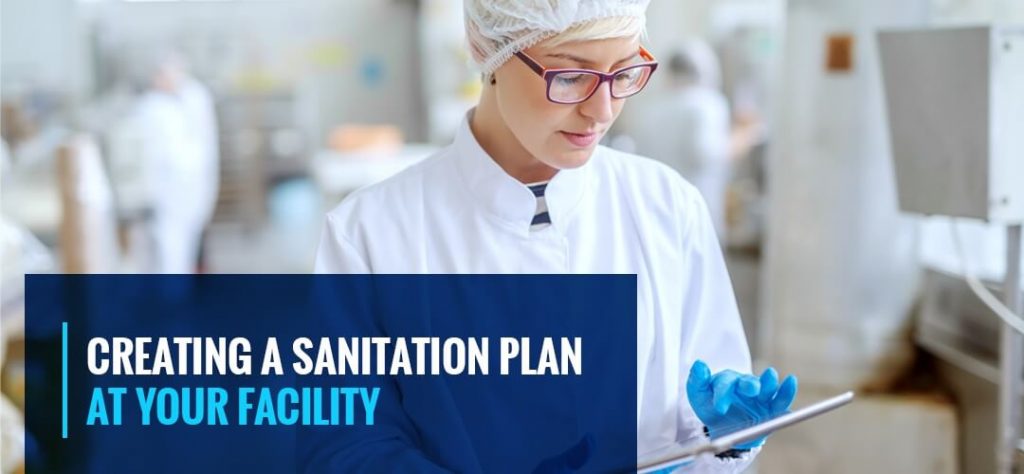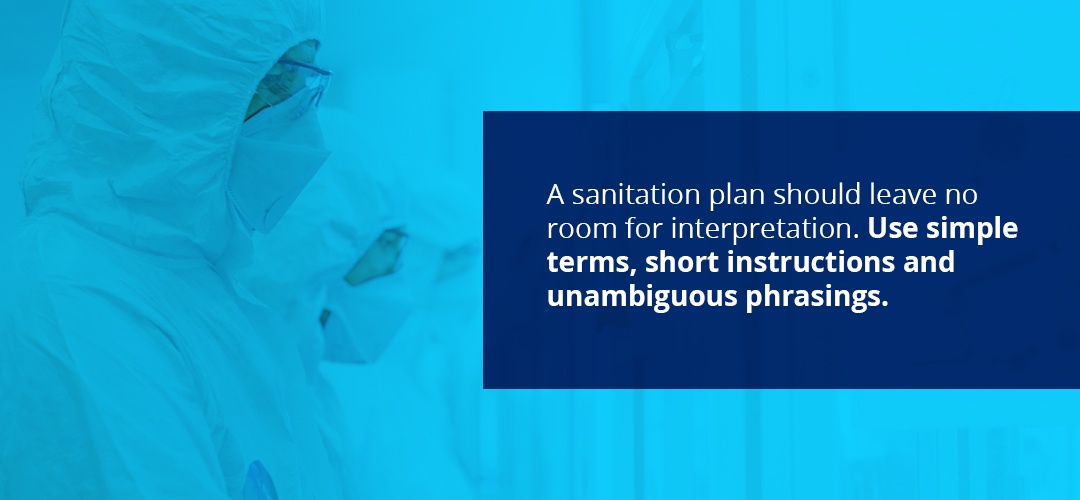
A robust sanitation plan is essential to the success, reputation and longevity of any food-processing facility. The Centers for Disease Control and Prevention (CDC) estimates that every year, 48 million Americans — one out of every six — become ill because of foodborne illnesses. Of those people, 128,000 end up hospitalized, and 3,000 die. Having an effective and reliable sanitation plan is critical for preventing outbreaks that contribute to these numbers.
Let us help you with creating a sanitation plan for your facility to ensure clean equipment and surfaces for safe food processing. Read on to learn more.
In This Article:
- What Is a Sanitation Plan?
- What a Sanitation Plan Should Include
- Sanitation Plan Example
- Tips for Writing a Sanitation Plan
What Is a Sanitation Plan?
A sanitation plan is a written set of steps and guidelines that outline the way your facility will clean and sanitize all areas, including food-contact surfaces, non-food-contact surfaces, equipment and utensils. Generally, a sanitation plan should focus on reducing hazards and contaminants that could render food products unsafe for consumption.
The formats of different sanitation plans may vary, but all sanitation plans should provide precise written instructions to ensure thorough and effective cleaning and sanitizing. They should outline how to remove dirt, residues and microorganisms that could contaminate food products and lead to an outbreak of foodborne illness.
What a Sanitation Plan Should Include
Sanitation plans can be written in different ways, but generally, a viable sanitation plan will include each of the following four elements.
1. Designation of the Person Responsible for Sanitation
One person or one clearly designated team in a food-handling facility should have overarching responsibility for the sanitation program. This person or team should be part of the management staff and have the explicit support of the facility manager.
The responsibilities of this person or team should include the following:
- Development of effective cleaning schedules and protocols
- Training and supervision of sanitation employees
- Implementation of a self-inspection program to confirm that employees have thoroughly cleaned and sanitized all areas of the facility
2. Written Cleaning Protocols
A facility’s cleaning protocols should elaborate on step-by-step procedures for cleaning and sanitizing each area or piece of equipment. Written cleaning protocols provide a clear description of the correct way to perform cleaning steps. They can serve as reminders for established employees or as training tools for new employees.
Often, the cleaning protocols contain a list of all the equipment and cleaning supplies necessary to complete the required tasks. These may include mops, brooms, rags, brushes, scouring pads, hoses, spray bottles, pump-up sprayers and other supplies as needed. The specific items on the list may differ depending on the requirements of the task. The specific chemical cleaners and sanitizers necessary should also appear on this list.
The written cleaning protocols should also specify the personal protective equipment (PPE) employees should wear while they clean equipment. This PPE may range from gloves and goggles to decontamination suits, face masks and rubber boots for more hazardous procedures.
The most substantial portion of the written cleaning protocols will be step-by-step instructions for how to perform the necessary tasks. This portion should be extremely detailed and describe every step, including the following, if applicable:
- Prerinsing of the surface
- Preparation of chemicals
- Application of the cleaning chemical at a specific temperature and concentration
- Rinsing of the chemical
- Application of the sanitizing chemical at a specific concentration
3. Written Cleaning Schedules
A sanitation plan should contain written cleaning schedules in addition to written cleaning protocols. The cleaning protocols instruct employees on how to clean various surfaces and equipment. The cleaning schedules tell employees how often cleaning and sanitizing should take place and assign tasks to specific members of the cleaning and sanitizing team.
Food-processing facilities might set up their cleaning schedules in different ways, depending on their needs. Facility size, available staff and the types of products and equipment available all help determine the style of schedule that works best. A facility might set a daily schedule that specifies tasks an employee on the cleaning team must complete each day. Alternatively, a facility might set a master cleaning schedule that specifies tasks to be completed at less frequent intervals — weekly, biweekly and so forth.
4. Self-Inspection Procedures
Self-inspection procedures are crucial for helping a food-handling facility evaluate the effectiveness of its sanitation plan. Facilities should create and adhere to self-inspection procedures so they can assess plan effectiveness.
Self-inspection procedures should include a couple of different types:
- Preoperation inspections: These inspections typically take place before daily production has begun. They concentrate on the cleanliness of food-contact surfaces, though they should evaluate the general food-processing environment as well. A preoperation inspection is often a visual inspection, though it may include a bioluminescence test or taking swabs of various surfaces. The facility must take steps to address all contaminants found before processing operations can begin.
- Monthly self-inspections: As their name suggests, these inspections take place once a month and encompass all areas of operation — food-contact surfaces, equipment, floors, walls, ceilings and drains, as well as warehouses and storage areas. The facility must document these proceedings and take corrective actions to rectify contaminations.
Sanitation Plan Example
A sample sanitation plan might look something like this. Keep in mind that sanitation plans can vary in complexity according to industry and facility needs.
Company: Little Dipper Ice Cream
Sanitation Standard Operating Procedure (SSOP): 101
Date updated: February 15, 2020
Target: Ice cream processing equipment, including vats, mixers, batch freezers and utensils
Cleaning and sanitizing schedule: Ice cream processing equipment must be cleaned and sanitized before production begins every day.
Cleaning procedures:
- Put on protective gloves.
- Take equipment apart and rinse the parts with warm water.
- Fill the sink with warm water and add 3 tablespoons of XX cleaning solution. Mix until dissolved.
- Scrub parts with a clean brush or scrub pad. Be sure to scrub all surfaces and parts.
- Rinse parts with warm water. Be sure to remove all cleaner residue.
- Inspect parts for remaining particles or cleaning residues. If necessary, repeat processes until equipment is clean.
Sanitizing procedures:
- Fill a large bucket with lukewarm water.
- Add 2 tablespoons of powdered sanitizer (XX sanitizing company) to the water and stir.
- Sanitize equipment using a clean brush or rag. Be sure to reach all parts of the equipment. Let the sanitizing solution sit for at least 60 seconds before wiping it off.
- Inspect equipment for particles or residues. If necessary, repeat processes until equipment is clean.
Recordkeeping procedures: The employee who performs cleaning or sanitizing tasks must date and initial the cleaning schedule each day.
Person responsible for inspecting the sanitized equipment: Daily shift manager
Person responsible for implementing this SSOP: Jane Smith
Title: Little Dipper Ice Cream General Manager
Date implemented: 2/15/2019

Tips for Writing a Sanitation Plan
Creating a sanitation plan for your facility is straightforward with a little advance thought and planning. Below are some tips to help you get started:
- Be clear and concise: A sanitation plan should leave no room for interpretation. Use simple terms, short instructions and unambiguous phrasings. If your facility employs staff members for whom English is not their first language, be sure they understand the details — and consider translating your sanitation plan.
- Be thorough: It’s not enough merely to enumerate a few steps in the cleaning process. Your sanitation plan should describe the steps thoroughly so employees know exactly what is expected of them when they clean and sanitize. Your sanitation plan should be detailed enough that a new employee could follow the steps precisely, though, of course, new employees should also receive in-person training.
- Keep documentation: Keeping comprehensive documentation on your sanitation plan is critical. Monitoring records serve as proof that you have implemented a sanitation plan and that employees regularly complete the tasks it requires. Monitoring records can include items such as dated and initialed cleaning schedule logs, chemical concentration logs and routine checklists for the master cleaning schedule.

Contact Log10 for Help With Creating a Sanitation Plan for Your Facility
When you need to create a reliable sanitation plan for your food-handling facility, let Log10 be your trusted source for guidance. Through our consulting services, we can assess your facility and help you create a customized sanitation plan to help ensure the quality of your products, prevent harmful outbreaks and keep consumers safe.
